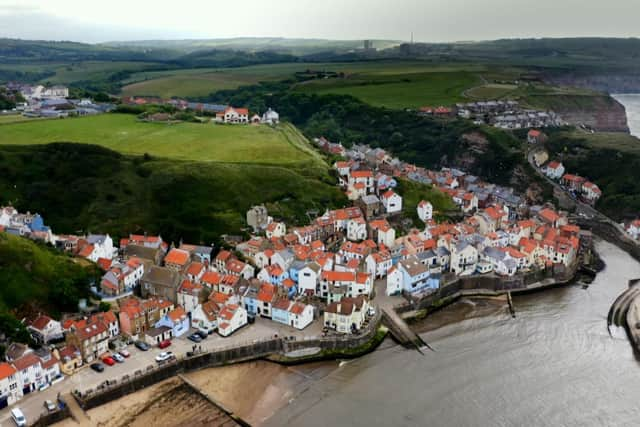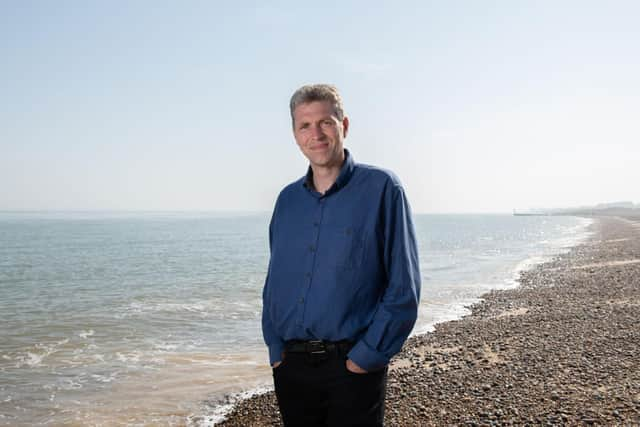Staithes' hidden history to be explored as BBC Two's Villages by the Sea stops in North Yorkshire
Staithes has earned a reputation as a picture postcard holiday haven leaving the masses charmed by its traditional fishing village idyll.
Archaeologist and broadcaster Dr Ben Robinson, though, hopes to unveil the hidden history of the North Yorkshire spot to show that it offers much more than just maritime heritage.
Advertisement
Hide AdAdvertisement
Hide AdIt also boasts a past that involved the surprisingly resourceful contents of locals’ chamber pots – and those from as far as London – to help power another major British industry from the Yorkshire Coast.


“Some of these places are familiar to people, they’re holiday destinations, they’re places people have heard of and maybe visited for a day but they’ve all got more to them than first meets the eye,” says Dr Robinson.
“They’ve all got hidden stories and hidden significance that maybe people who’ve been to them won’t have recognised before and won’t be obvious to them.”
He explores this by presenting the second series of BBC Two’s Villages by the Sea, which returns next Monday. It comes after his book, England’s Villages, also recently hit the shelves.
Advertisement
Hide AdAdvertisement
Hide AdDr Robinson knows Staithes from decades ago, when he was a student at Teesside Polytechnic and later when he earned his PhD in York.


In the second episode from the series, though, Dr Robinson arrives back in the village in using a coble boat.
He tells The Yorkshire Post: “Until you’re actually out there in the sea staring at those massive cliffs and the waves at the foot of them and see this inviting little entrance to a harbour, it doesn’t really dawn on you what that means. It’s suddenly obvious – yeah, this was one of the only places where you could get sizeable cargoes in and out. And once you start realising that you think, right, okay, so that’s been true over centuries and centuries and centuries and that’s why it’s so crowded down here.
“Everyone wanted to be in this place where all this action was happening, this north coast traffic on the sea coming up and down. It wasn’t about the roots inland, it was all about what was going up and down that coast. Staithes was ideally situated for that for centuries.”
Advertisement
Hide AdAdvertisement
Hide AdBut that’s not the whole story. Fishermen will report that it is actually quite a difficult place from which to operate. “Then you start to look more critically at the architecture and what you’re actually seeing and you realise, the village, no it’s not all about fishing. There are warehouses there that were storing alum and urine and there’s miners’ cottages. You know, up on Cowbar, those aren’t fishermen cottages, they’re terraces of miners’ cottages.”
He even suggests that fishing is a “tiny bit of the significance of the place”. Alum on the village’s shores was just as important to its success because it was essential in the textile industry as a fixative for dyes.
And urine was a source of the ammonia salts needed for the chemical process.
Villagers earned money by emptying their chamber pots into barrels placed on street corners. Of course, only so much could be procured locally – so boat loads of it would be shipped in from London, Newcastle and Hull.
Advertisement
Hide AdAdvertisement
Hide AdDr Robinson says that earlier in history, “people didn’t quite understand how the chemistry worked so they were almost alchemists, like the old sort of magicians or something... trying to find gold out of base metals. Chucking all sorts of things in just to see what worked and what could help a process along. So I think almost by accident, human urine, waste... has been used for all sorts of things over the centuries and I think they just came to a point where they said ‘We need something. That seems to do this in some other environment, so probably it will help us with the alum process, so we need loads of it’.”
He adds: “The thing about the Staithes area is, the industry was massive, was bigger there than anywhere and, again it’s something that’s forgotten now but alum was absolutely critical. If you didn’t have alum you couldn’t have dyed clothes and if you didn’t have dyed clothes, it’s not just about the pomp and finery and so forth, it’s everyday wear and it’s about being able to export good cloth to other countries and we had the technology to make good woollen clothes. We had the technology to make excellent cloth, but if you can’t colour it and dye it, you can’t compete with the world market.
“The country was a world leader in textile production and the Staithes area, those quarries there, were absolutely key to the success of this industry.”
Whatever the source of Staithes’s past fortunes, people love to visit in the present. Interest intensified after its use as a location in Hollywood director Paul Thomas Anderson’s 2017 film Phantom Thread and, last Christmas, Bob Mortimer and Paul Whitehouse’s Gone Fishing.
Advertisement
Hide AdAdvertisement
Hide Ad“I can see that it’s changed a bit over time, it has become more popular, and possibly (there are) more holiday homes. But I think places that are special and places where people want to be is also a gift in many ways. Not just to that place but to the places around.
“If people want to come and visit and spend their money and support local businesses and help in the life of the place then I think that’s fine. And tourism – some of the programmes investigate this – is a very big industry for the country and for regions now.
“Just as big as some of these (other) big industries have been in the past and that has to be taken that seriously. And I think the pandemic has shown that there’s a thirst for wanting to explore our own patch and we have to kind of respond to that.”
Archaeology, or simply looking up and taking note of what’s around you in a place, can only improve a visit, says Dr Robinson. “If you delve a little bit deeper and you understand the history of a place, for me, that can only mean that you appreciate it even more.
Advertisement
Hide AdAdvertisement
Hide Ad“If you understand what it’s been through over history, how it’s become the place it has, what’s happened to it over time, all the events, all the hard work, all the labour that’s gone into making a place, you can only look around and say: ‘Yeah, it’s beautiful, it’s pretty, it’s wonderful, but my goodness me there’s a rich story of hard work, effort, investment, entrepreneurs, people doing their best to make something here’.
“So that for me is what it’s all about – really appreciating these places for their rich history.”
The new series of Villages by the Sea starts on BBC Two next Monday.
